Don your highborn cloak: Ralph Lauren, saviour?
I recently finished reading In His Own Fashion, the official biography of Ralph Lauren, which Alan Flusser kindly gave me last year.
I’d recommend it to anyone - it’s both interesting as a history of fashion in the past 50 years, and inspiring as an extended essay on menswear.
It is not an objective view by any means. If you want something journalistic, you’re better of reading Genuine Authentic by Michael Gross.
Alan raises occasional points of controversy - including the accusation that Ralph plundered traditional cultures such as the Navajo - but only to neatly deal with them, in this case by pointing out that he was later honoured by the American Folk Art Museum.
And Alan’s writing has a tendency towards the flowery, perhaps even fluffy. He will talk of Ralph trying to “represent a plateau of taste that would catapult him above the clutches of fashion’s artifice and impermanence” - words that are by design emotive rather than explanatory.
But that emotion can also be genuinely inspiring. For example he says of the polo coat: “To ensure the classic mantle’s survival, Ralph had to defend it on multiple fronts and over multiple decades. First, he had to protect it from becoming a casualty of the anti-establishment sixties; then he had to defend its honour during the decades of designer-driven fashion excess.”
The next paragraph makes you want to get yours out of the closet, and wrap it around yourself as you continue: “Whether vintage or new, custom or ready-made, this highborn cloak has long been depended upon...From blue jeans to formal-wear, bowlers to baseball hats, there is no style boundary that this blue blazer of outerwear cannot navigate.”
OK, are you wearing your ‘highborn cloak’? Next are the chapters on Ralph’s background.
These are superficially interesting, but there isn't really much on his personality and character.
The highlights are always the points that turn on clothes. Such as the ‘pants and pearls’ look of Katherine Hepburn, that he so loved (and would later be a foundation of his women’s line) or the teenage gangs in Mosholu Parkway: the ‘rocks’ in black leather jackets and the ‘preps’ in crewnecks and penny loafers.
Strikingly, the thing that stands out in the next section - charting Ralph’s rise through the industry - is how unappealing his clothes are.
No matter how they are described, or how successful they seem to have been, Ralph’s super-wide super-thick ties sound horrible.
Topping out at four or five-inches wide, they were made of upholstery materials, such as velvet and silk tapestries. And they were usually as wide in the neck as they were in the apron. As Alan says, “the necktie’s sheer bulk attracted attention on its own”.
The tailoring isn’t much better. Although frequent references are made to the understated elegance of Fred Astaire, or Paul Stuart legend Cliff Grodd, the RL suits are extremes of fashion.
The lapels are so wide they hang off the side of the chest; the shirts are loud, with contrast collars; some of the trousers have a large chain-link pattern running down their outer seam (examples below).
It’s only when we get into the early 1970s that the Ralph Lauren look seems to mature. He is in his mid-thirties, has been doing this for 15 years, and the looks we know and love start to come together.
The polo shirt is launched, with a key selling point its full-cotton piqué and mother-of-pearl buttons, in deliberate contrast to Lacoste’s poly/cotton blend and plastic. (Interesting, given it’s fair to say quality is not a selling point of the Polo polo shirt today.)
The chino also comes into its own as a foundational part of the Ralph Lauren wardrobe. And Flusser is inspiring again:
“No article of men’s apparel facilitates as many dressing genres and clothing coordinations...Paired with a solid or patterned woven or knit shirt, any colour or model of sweater, sport jacket, or outerwear, the chino is the male’s idea of clothing heaven, the epitome of default dressing.”
Ralph also tries to sell unstructured tailoring, without much success.
Ironically, given the later success of Armani and the artisanal Neapolitans, it fails because customers persist in seeing an unstructured jacket as having less in it, and therefore less value. (Despite, of course, it being harder to make.)
In 1973, there is the watershed moment of Ralph’s clothes for Robert Redford and others in The Great Gatsby, where he finally gets to fully present his vision of designing dreams - not clothes.
“The notion of creating Gatsby’s suits and shirts - the beautiful shirts that made Daisy cry - was a dream assignment,” says Bloomingdale’s chairman Marvin Traub.
When these significant points in time come up, it’s particularly interesting to hear about their contemporary significance - something hard to appreciate from this distance.
For example, Alan says it “raised interest in American menswear in general. The first film in many years to glamourise male fashion, it introduced an entire generation to prewar American male elegance and taste, which back then was on a par with anything Europe had to offer.”
The other big changes come in the 1990s, with RRL in 1992 (earlier than I realised) and Purple Label in 1995.
Purple Label is the Ralph Lauren I grew up on. Rich brown leather, dark-green suede and charcoal flannel; tie bars and dimpled tie knots. Deeply aspirational. I remember particularly loving the image above, with its textured greens and shiny browns - even though I'd look ridiculous in it.
Interestingly, when Ralph showed it as a collection for the first time, he deliberately described Purple Label as the antithesis to the ‘dress down’ trend: “Men can look cool, sexy and elegant at all ages in sophisticated clothes. It doesn’t have to be trendy; it doesn’t have to be flashy," he says.
"The most important thing was that it’s not this year’s look, it’s a forever look.”
By the time the menswear section of In His Own Fashion concludes, you are fully bought into the fact that Ralph Lauren has been the saviour of classic menswear.
He may not have been quite as pivotal on trends as the book suggests (to read the women’s section in particular, you would think he pioneered every fashion from 1970 onwards).
But the evidence of continuity is too overwhelming elsewhere, particularly with menswear. Fans of Ivy League style may not like the way Ralph Lauren commercialised that look, but without him it seems likely that it would have died some time around 1968.
And since then, he has consistently defended it, no matter how out of step with fashion.
The same goes for Western clothing, which flows in and out of collections every year, or for Southwestern crafts and patterns, which a new generation is discovering almost 40 years after it was introduced by the 1981 Santa Fe collection.
For a diehard fan of classic menswear, Ralph Lauren will always be offering some clothes that are too fashion.
But look around at the competition - the other fashion houses, which trumpet revolution every year or two, under a new creative director, and try to sell a whole new look.
In a world like that, Ralph Lauren is still the closest thing to the ‘forever fashion’ he has claimed the brand is about. And that’s just a couple of synonyms from Permanent Style.
“I propose Ralph as not only our generation’s preeminent tastemaker, but also the leading guardian and ultimately the saviour of high-class taste and style,” says Alan. “As his influence widened, Ralph forged a bulwark against the culture’s deteriorating taste level by championing time-honored style over fashion’s more provisional solutions.
“Reinvigorating the public’s interest, he ended up democratising it more profoundly than any of his peers - and maybe more than anyone in modern history.”
I've always felt this way about Ralph Lauren - as I briefly set out in my recent grey-on-grey outfit.
My whole adult life, Ralph Lauren has managed to present clothes each season that feel fresh yet familiar; new, yet completely him; and across an amazing range of styles, from cowboy to sailer to banker. No other brand has come close to producing so many clothes, and defending so many styles, that I love.
It's nice to have someone put it all into words.


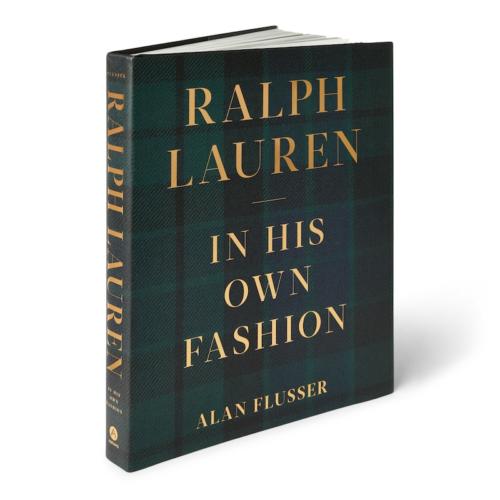
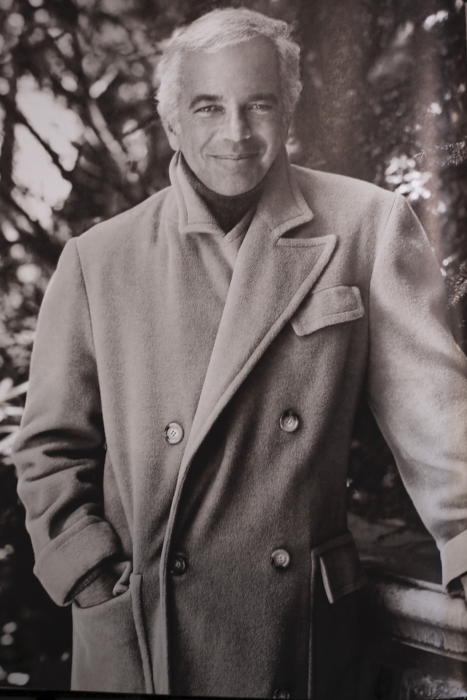
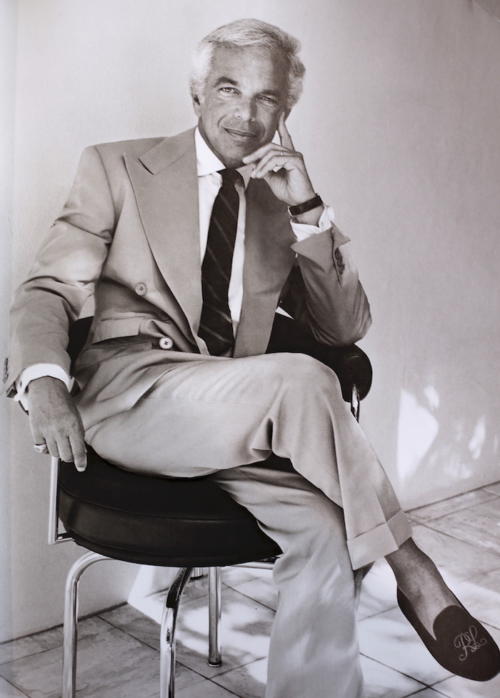
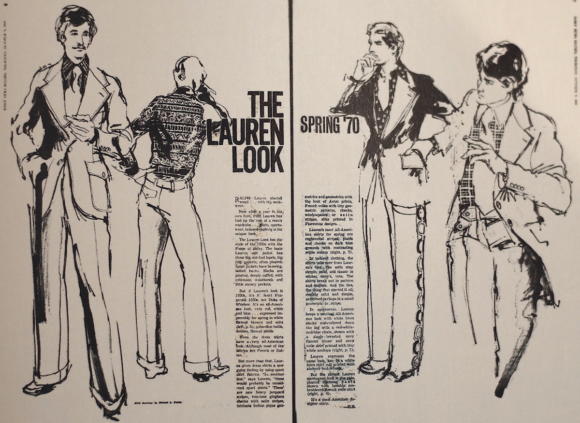
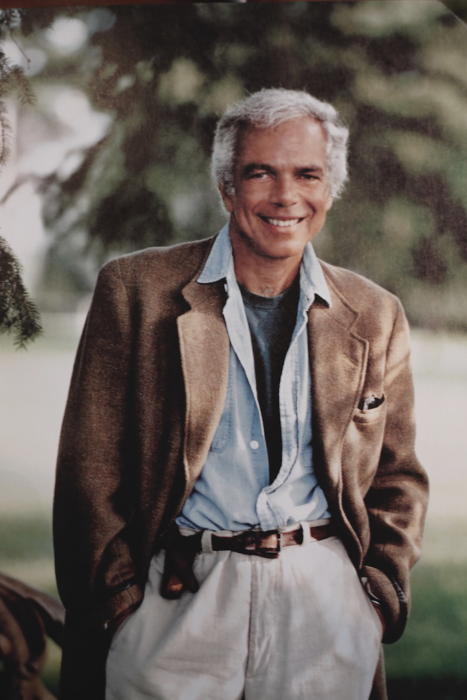
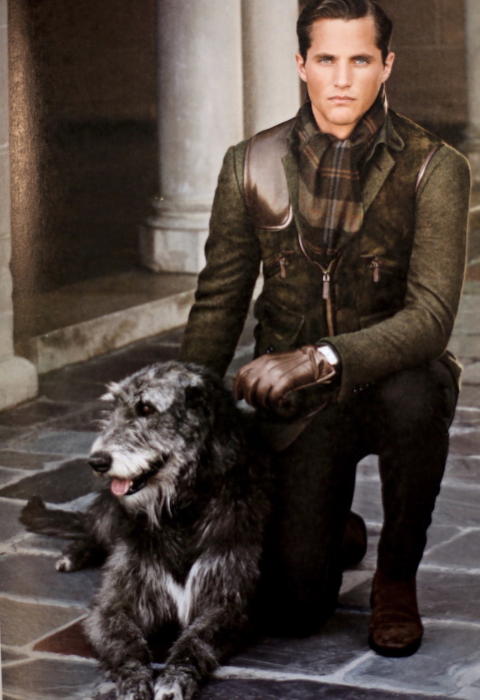
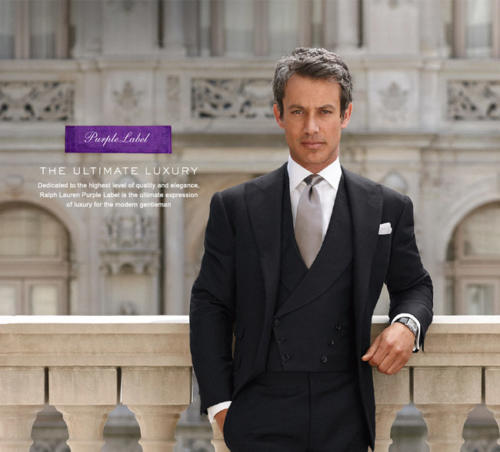
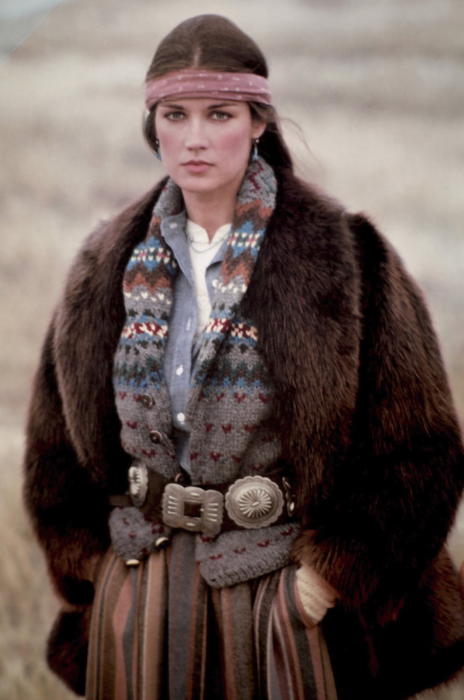
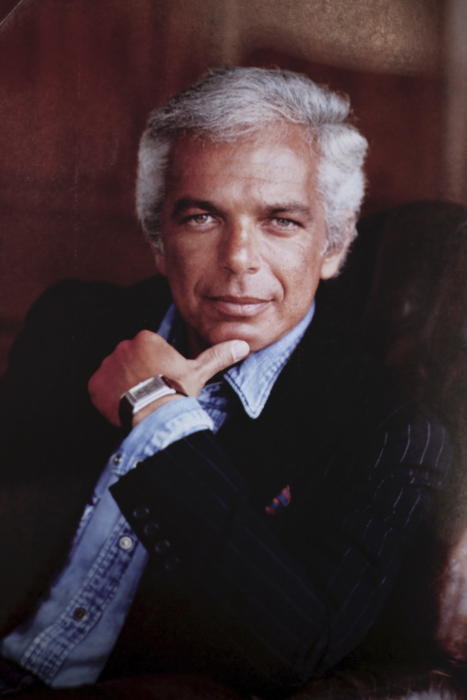


























Honestly you do not talk bout Ralph enough.
What a legend that man is. Loved his style in my teens and still love some of his stuff. I remember buying my first navy Polo polo in 84 having seen Magnum P.I. wearing one with way too short shorts 😉 Still have it somewhere in the attic. Got to admit though that the quality of his polos even in the 80ies were rubbish compared to Lacoste. They lost their color and shape after a couple of washes and just looked cheap. Still loved them back then nevertheless.
I still remember buying my first polo, in the smaller shop on Bond St that became the kids store for a while, probably in 1987/88, £35 for a fushcia pink Polo with turquoise polo player, made in the USA back then too I think.
I can’t find it now but I have a very similar one (albeit a lot less baggy) from a few years ago. It seemed a bit scary spending that amount of money on a polo shirt back then, but I loved it.
I have bought many more Ralph Laurens polos and other clothes since then and still enjoy browsing their so well put together shops.
Long love King Ralph.
This brand is a textbook marketing exercise.
The vast majority of what is sold using the RL and Polo logos is of no better than average quality manufactured in huge numbers in countries where the cost of production can be kept as low as possible. The hype though means prices can be kept relatively high.
Anything of true quality is only a tiny part of the empire.
In certain markets you can buy “home adornment” so you can actually build the RL story into your home, despite again the majority being low quality/high price.
Well done to the marketing team.
You’re not wrong, particularly for the Polo line, and I think far less should be spent on marketing by all big brands.
But just to play devil’s advocate for a moment, I think we can underestimate the pleasure we get out of some things that we might call marketing. Such as the imagery and styling in those adverts we remember. Like the merchandising that dresses every store – and is done better than probably any other brand.
They don’t need to fly teams of people around the world to do that (which they do, at enormous expense). It could be done on a much smaller scale – as new menswear brands are demonstrating. But the world would be a poorer place if we didn’t have some of those old campaigns.
I agree it is all about marketing and you have to be selective to find things worth the money.
I think they get the store experience about right most of the time, although some of the Regent St staff are a little eager.
But when I was 18/19 it was truly aspirational. Now I would rather buy something more authentic but I do still dip in from time to time, and the shirts and polos do seem to last despite the mass production.
Having been to the outlets over the years, the volume of clothes made is staggering, but I guess that is the same for any large brand or retailer.
Some of the RL Home things we have bought, like bed linen, has lasted very well.
Im not sure I can agree with this, you are correct that most of the garments are made by factory production in low cost countries. I dont like particularly like this myself. However, the cut and design of many of the items especially in the casual ranges is so often unbeatable RTW. At the price point they are selling, say £150 for a jumper, its to be fair way cheaper than the hashtag menswear route which involves spending say two or three times this. Go to a Anderson and Sheppard Habedashery, Stoffa etc and check their prices on knitwear, you’d be lucky to spend less than £500 if not your teeth on a piece of knitwear. You go into RL and buy casual, not tailoring, and 9 times out of 10 you will come out better looking than most men shopping at hashtag menswear darling boutique brands casual or in fact bespoke tailored which so often end in disaster. Just peruse forums or instagram to get an idea of this.
I really enjoyed the HBO documentary recently, and in the book I realised that in Trading Places Dan Ackroyd’s stunning fiance(pictured above) was a model for Ralph!
I found the HBO documentary a little too fawning, to be honest, and without much substance. I know a book has more space, but they didn’t even seem to try and make any interesting points in the doc.
I KNEW she looked familiar!! Thanks Ian, haha.
It’s easy to find faults with a brand that sells at so many different price (and quality) points but overall there’s a remarkably consistent aesthetic across the various lines, and I love how Ralph Lauren has brought so many styles into public consciousness in a way the traditional makers (I usually now favor) never could.
I remember as a teenager the Polo Harrington jackets (almost always fake, picked up from a sketchy guy at the market) were THE must-have item. But I will never forget the thrill when I was finally able to finally afford a REAL polo shirt. Marketing or not, those kind of experiences are special. And now, in my late 30s, with more disposable income, I still get that same thrill from Purple Label items. How many brands can do that?
Thanks for this interesting review. I wonder, do you have a recommended reading list of books on menswear? Unexpectedly, I find I have some time on my hands…
I did do this list a while ago, yes. However, it could probably do with an update.
Of course, I’d recommend all my books too, but would refrain from doing so directly.
Thank you, Simon. Off to the online book shop I go.
A contrary opinion.
There was (I think) already a Ralph Lauren store in South Florida when I arrived there in 1981. It was the sort of place you’d want to live, much as now. I also “discovered” Brooks Brothers and their iconic OCBD. RL had similar shirts, except Lauren’s shirts were smaller. The collars didn’t roll, the shirt body was shorter, there was no chest pocket. It looked and felt like what it was: an inferior copy. Ralph Lauren has always been a highly derivative designer. He takes classic British looks (or western or Native American or Ivy League) and makes copies of them and markets them extremely well into, as Simon writes, highly aspirational lifestyle items. I don’t believe for one moment that Ralph Lauren “saved” the Polo coat. A Polo coat has always been available at other places, usually for less money (and arguably more “authentic”, too).
As I realized that Lauren was essentially making copies of clothes and looks that already existed, I began to look for the originals. That was much, much more difficult in the dark days before the internet. But Fitzgerald pointed the way in the book “The Great Gatsby”. The shirts that made Daisy weep were from Turnbull and Asser, not Ralph Lauren. And I think that was a large part of RL’s value proposition: he had done the research for you and offered reasonable copies of those looks, off-the-rack. Even Purple Label is a pastiche of bespoke tailoring and is priced higher than much genuine bespoke tailoring at that.
Ralph Lauren offers a sort of one-stop shop for certain looks. But I’ve always found his clothes to come up short and ultimately disappoint. Look behind the curtain. Find the originals that inspire Ralph Lauren. I think that’s a much better way. Buy a Polo coat from O’Connell’s (or, once upon a time, Brooks Brothers) or have one made, for example.
Speaking of derivation for a moment, I saw a tag line for Tom Ford’s most recent collection as “inspired by Mick & Bianca Jagger’s wedding” (which took place in the early 70’s). What is amusing about that, of course, is that Ford is more or less blatantly copying Edward Sexton (who made both Mick’s and Bianca’s suits). But unless you knew that Sexton was the original, you might assume, quite reasonably, that the look that Ford is copying just, somehow, existed on its own, unattached to an original visionary who came up with the look in the first place. Which is what Ford wants you to think.
I think Ralph Lauren and his brand are a genuine American success story, worthy of respect and worthy of study. But I do not believe that he is an original designer nor did he save menswear, classic or otherwise. For that reason, I do not share nor understand the reverence in which he is held.
Thank you very much Andy, and you make some very good points.
I think one small thing to say from the opposite side is that Brooks Brothers shirts might have been like that in 1981, but they are not today. Most of the Ivy places that Ralph was either inspired by or copied, no longer exist either. He has outlasted them, and in that way has been the only one keeping the styles going.
And more importantly, the way in which he has saved styles is not just making them available, around the world. It is advertising them, selling them, styling them, keeping them relevant. It might be possible to buy a polo coat from O’Connell’s, but only a tiny fraction of the world would know what one was, or see the attractions in it, if only shops like that sold it.
I enjoy this healthy discussion – if you have any further thoughts please do add them. As we all know, none of this is black and white (in this day and age: thumbs up or thumbs down), and I think discussions like this between people such as ourselves can help show that.
Simon
Sounds like Andy and I have been on a similar journey.
I have worn RL as the mainstay of my off duty wardrobe for most of my adult life. I dread to think to think of the number of RL Chinos that have been cycled through my wardrobe (Cotton, Linen, Silk mixtures, endless colours). I used to love the quality of them, they used to give me a year of ‘smart’ wear, a year or 2 of that more washed out, softer casual ‘holiday’ wear and then became my gardening trousers of choice until my wife would finally consign them to the recycling… great value. T
hen the realities of mass manufacturing kicked in and the quality declined, across the range and slowly, just like Andy I realised there was nothing new here just a great marketing machine selling some classic staples and styles.
And now to the point of the post… because of blogs such as yours Simon suddenly one becomes aware of small makers and artisan making the originals and one leads things to another, and suddenly one becomes interested in where things come from and how they are made. Now I seem to spend hours on endless journeys across the internet finding makers that appeal to my values. The wonderful thing is now many of my clothes have a story behind them about where and how they were made. And that adds value in its own way.
RL continues to provide me with a useful ‘Look book’ each season, but when I see something I like off I go trying to find a more ‘genuine’ version. The searching is as interesting and as much fun as wearing the clothes when I finally find them.
I think you are right Simon, RL has kept many of these style alive and now (or rather pre COVID-19) the internet and our renewed interest in small makers potentially provides a future where the small makers can make a living serving those of us who see more value in the clothes than the embroidery of a little man on a horse…
Sort of tangential, but expanding on what Stewart says above, I wonder, Simon, if you are interested in exploring the impact of COVID-19 on the future of fast fashion and how that might impact buying decisions for menswear in the future. The Guardian published an article yesterday titled “Arcadia Group cancels ‘over £100m’ of orders as garment industry faces ruin.” This certainly will have a significant impact on livelihoods in developing countries, but, realizing that women’s fashion is the bigger draw for fast fashion, I wonder if/how it will change the menswear landscape. There has been some discussion on how small makers and tailoring houses are facing challenges, but less on this other angle.
Hi Christopher,
Interesting point. I do think it could have an impact, given what small margins those mass-market companies work on, and reliance on international supply chains. But it will be pretty small on menswear from that point of view – there is much less hype-driven clothing of that type in menswear.
Still, an interesting article but perhaps one that needs another month or so at least to make a decent stab at the long-term effects.
Simon, your point about Brooks’ shirts not being what they were forty years ago is a good one. Somewhere down the years, Brooks lost its way. You’re also right that a good many of Lauren’s sources and inspirations have disappeared. I have to wonder, however, to what extent competition from Lauren itself contributed to the demise of those places (although I’m sure there were plenty of factors involved)?
Rather than revere Ralph Lauren as a designer, I think a recognition of his and his company’s brilliance as marketers is well worth researching and understanding. This, I think, goes to your point about broadening awareness of clothes like Polo coats.
Hi Andy,
You’re right, I’m sure Ralph’s success didn’t help others, but on other areas it seems very possible for more than one designer to exist, as it is in our little world.
I also think you’re right, that in the end marketing might be the greatest achievement. But I’d put stylist, rather than designer, a close second.
Indeed, I think there’s an interesting parallel there too with our world of classic menswear. Most men, brands and shops I admire in it are great stylists, rather than designers. There is little really original, but great style nonetheless.
Yes, “stylist” is a much better word to describe him and I will agree that the way he combines his influences into a coherent look is really superbly done.
Edward Sexton looks more exaggerated than TF though, TF’s 1st cut (Windsor) I say is easier comfort level to climb for most guys than full on Edward Sexton when take to the 10s
I think you make my point about Tom Ford being, essentially, a copyist rather than an original designer. But I don’t think that Sexton is now or ever was all that difficult to wear (which I think is the point you’re making). Sexton’s house cut is very much a throwback to the Nutter days, but his RTW styles are more restrained. I also think that if you commissioned a suit from Sexton you would not get something that looked like it was fresh out of the early seventies.
My point really comes down to this: which would you rather have, the original or the copy?
I think that’s a bit simplistic Andy. Tommy, too, had many influences, and a lot of suits at that time had similar proportions. It wasn’t ground-breaking design – the thing that was significant was making it on Savile Row, and getting the famous to come have it made there.
And so we come back to marketing, don’t we? Leaving Ralph Lauren aside, who do you think is the most effective at marketing in menswear at the moment?
Good question. I think many brands in other areas, such as Louis Vuitton and Supreme, are good at marketing, but it’s a broad term, and their marketing is a very different type – built on celebrity, exclusivity and hype.
I think the comparison actually highlights how good Ralph Lauren is at marketing through style. I can’t think of another brand today that is even close to marketing so effectively based on a cohesive style. There is little there but newness and levers intended to pull at desirability.
Actually prefer both, I don’t see things as cut dry as that
Andrew you think Sexton suits are easy to wear? Its highly structured tailoring, which means that you look like you are going to a (very) formal event at all times in it. How does that fit with most mens lives these days, unless you are a high level diplomat? Going to pickup your chai latte in Starbucks looks odd dressed like that.
On broader points about RL coping others designs, if those others were so good and people loved their products so much, where are they now? Most traditional clothiers and menswear shops have disappeared and ones remaining including tailors are like a needle in the haystack of the menswear. I would concur with Simon that RL has kept alive classic menswear in spirit if not in exact form. I must say that in many cases that is really for the best. We in the classic menswear community like to imagine some beautiful glorious past where all men looked elegant, sipping their gin martinis in perfectly tailored chalkstripe flannel suits like an Apparel Arts ad. Problem is that when you actually start finding some of these traditional items you often realise why men stopped wearing a lot of these garments. On the structured tailoring we mentioned above, not only does it look formal, but it wears hot and is stiff and uncomfortable. On the shirts inc the turnbull and asser you mentioned, they were and still are (in regular) cut like sails and blousey. Shoes were heavy and stiff. Coats were thick and heavy. Essentially its uncomfortable and impractical.
If you go for the ‘original’ as you put it, I guess it makes for an interesting aesthetic, I like the style of many historic garments. However, it doesn’t really fit well in the modern mans lifestyle. Peoples lives have whether you like it or not become more relaxed, with less formal type events, social structure has broken down meaning you don’t need to dress in a certain way to show social standing etc, we have central heating in colder climates.
Hi Simon, to what extent do you think the huge size of Ralph Lauren today has compromised the quality of the Polo range? When I purchased my first chambray shirt in about 1990 it was made in the USA from a fantastic fabric and had MOP buttons. These days the Polo range is all about quantity and quality has suffered.
The quality has certainly suffered over the years, and even when I was younger, the Polo range never really appealed to me that much.
But it’s hard to know whether that’s a result of expansion, or other decisions at a company level.
I guess one thing is certain, that it would be hard to make all the RL shirts in the world in the US today. But perhaps if they had stuck with those suppliers over the years, and grown with them, it would be.
I’ve purchased Polo polo shirts and Polo button down shirts second hand at a popular clothing resale store in my area that carries a lot of polo items for usually $12-$20usd each, and have found them to last and wear well. I like to buy them second hand because I can test the fit, and see and feel the quality. There are definitely some things with the polo name on them that are pretty poor, and some that are much better. Buying second hand I can filter out the bad ones. And since can I wear polo shirts nearly year round being in the southeast US, they’re a staple and thus buying them second hand I am able to put more money towards investment pieces (well made shoes, a nice PW VC bomber jacket, etc.). And while I could definitely buy polo new, buying them lightly used and picking the best out of a bunch gives a certain satisfaction. And it’s good for the wallet and environment of course.
Thanks for the article!
How does this compare to the Ralph Lauren by Ralph Lauren book? I get the impression that the IHOF book is more about the clothes and fashion empire and the RLRL book is more about the man. Is this roughly correct? The RLRL book seems to have an enormous number of photos…
I don’t have that book, but having flicked through it, yes it is much more picture driven, and about him rather than the clothes – there is no history of menswear or womenswear in that one, or analysis of styles and outfits.
Unrelated to this post, but interested to know why you chose to take your Instagram selfies in your bathroom? Doesn’t it rather detract from the “image” you are trying to create?
Pure practicality really – my baby daughter is normally asleep in our bedroom. Very inconsiderate of her.
I’m not that fussed about what image it creates of me to be honest.
Well said Andy.
As has already been mentioned, a very clever marketing machine.
Ivy League style would have died without Ralf Lauren 1968? Do you equate Oreppy with Ivy League style?
I think you fail to understand the American market. He is irrelevant to prep school and Ivy League taste, on the contrary, he depends on it.
This is not my opinion, Peter. It is that of an American writer who, although clearly with an agenda, knows more about this history than either of us.
slightly petulant simon. lockdown getting to you?
Driving me nuts.
Thank you Simon for another interesting article.
I first bought Polo clothes in the 1970s. The quality of the clothing for the price point was outstanding back then. I am afraid the same cannot be said today. However, throughout his entire career, Ralph Lauren has excelled at marketing an image, a desired lifestyle, a sense of taste that is largely associated with a logo. He has done this, arguablly better than any other designer in history. He has had several imitators over the years, most notably Tommy Hilfiger – (well actually Silas Chou and Lawrence Stroll – the businessmen who made Hilfiger and later Michael Kors into mass market brands) who have done well, but nowhere near as well as Polo. In some ways it is unfortunate Lauren decided to take his company public. The demands of quarterly returns to please shareholders is one of the reasons the items are made offshore, in huge quantities, at far less quality than the price should demand. Ralph Lauren will ultimately be remembered more as a successful businessman than a craftsman or designer. Money is the ultimate American benchmark. Design and craftsmanship will remain with those having lesser bank accounts, but held in greater regard, for their quiet daily efforts in ateliers across the globe.
Thanks Richard, these personal reflections are great. And good point about the public status too. Those I know who worked for Loro Piana used to say it was the only reason they were able to maintain their level of quality.
Ralph Lauren is really the quintessential American clothes designer. He brought quality tailoring and fabrics to the masses so he gets a lot of credit for that. I always resisted wearing anything with a polo pony on it, but I would make an exception for the short-sleeved genuine madras shirts. I still hunt for those in thrift stores and online. I have a pretty good collection of those.
The Purple Label is “overpriced”: a suit made in Italy retails at £ 3200.
I used to buy BELVEST suits, way back when. Better value…..
Simon,
I have generally been impressed with RL’s purple label offerings, and while his more regular offerings can show too much brand (“RL”, etc.), he generally won’t leave you looking dated.
Interviews I have read with him, the length of his marriage, the fact he seems to be a good father (and a great car collector) speak to someone who is aware of being/looking authentic and genuine…..
How then to explain his comb – over? I find comb overs to be the most fundamental level of self deception, and one that believes they are fooling the people around them.
Does he not have a stylist who can guide him on this?
I too fondly remember purchasing and treasuring my first polo shirt and OCBD, from Woodbury Common outlet on my first trip to New York (from the UK) many years ago. Not that I purchase so much from RL now.
As for value, I tend think items are worth what you are willing to pay for them or not.
Thanks for the interesting article Simon and to all who have contributed to the debate in these challenging times.
I liked the book as well. It was a bit too polite though. It missed a big and interesting part in Ralph Lauren saga and that is Rugby. What happened with it? Why was is discontinued?
Interesting discussion. For many years I associated Ralph Lauren clothing with Preppy jerks. A product of my youth in the late 70’s and early 80″s.
It took many years before I bought any Ralph Lauren clothing. I have two shirts – one I love and wear regularly and one that sees little use and would fall into the “overpriced” category.
The discussion here has me wondering what makes one person see a designer as simply a copier or marketer while another sees that same designer as creative and inventive?
Is it size? Does that give a reasonable basis for calling a mass producer like Ralph Lauren a copier but giving Drake’s a pass? Doesn’t Drake’s essentially do a lot of “copying” of Ivy and English country styles? What makes us consider one “authentic’ or “faithful” to a style while another is considered a “copyist” or “imitator”?
This is not a criticism of Any’s and other’s points. I’m genuinely curious about how we come to these judgments.
I mean there was definitely some appropriation, my grandparents dressed in a very angloinfluenced American look because that’s what was prevalent at the time, and graduated to English bespoke after uni. He made something that was very patrician accessible to many. To be completely fair he probably is the sole reason the style is still dominant today.
My first thought on seeing the name Ralph Lauren is always “Urgh. Overpriced; massive logos; a marketing machine disguised as a fashion house.” RL was one of the first ‘proper’ brands to which I was introduced as a youngster, on a rare window shopping trip to a shopping mall in Manchester instead of the usual local precinct in my worn down northern town. I loved the clothes in the window display – maybe the first I’d seen that was arranged with some art and visual intrigue, in opposition to the brightly lit minimalism of the windows at M&S and C&A – but the price tags made my ears bleed and I couldn’t see how the quality justified it. I discounted the brand as overpriced tat sold to the gullible.
Today, though, as I saw the article heading, I realised that the long sleeved grey polo shirts that form the core of my wardrobe for lounging about at home are all Ralph Lauren. I still haven’t changed my opinion about the brand, but without my noticing it has become the brand I wear more than any other, for no other reason than that the polos are intensely comfortable, casual enough to wear as pyjamas but not so casual that I can’t change into trousers and quickly pop to the shop downstairs.
Small pony, though. I’m not a monster.
What you say here resonates with me a lot. I know its mass produced, in a low cost economy, and that a load of bores buy their stuff. However, I wore a black polo for years happily, I bought and sleeveless argyll knitwear vest in there last season and it fits and wears great, bought a denim shirt which tucked in gives just the right amount of cool American western cowboy vibe. Quite simply there are too many things which look fantastic being produced there. Some things are naff, pretty much all the trousers and jeans, the tailoring apart from RLPL which is overpriced but in a modern way very flattering. If you go with an eye Ralph is still putting out things which are amazing. Just to add Ive bought things bespoke tailoring wise which were hand made on Savile Row and been disappointed several times. What good is craft and heritage if the cut is off, or workmanship sloppy?
Simon, for anyone interested in Ralph Lauren, I recommend the article “American Dreamer,” which the architectural critic, educator, and contributing editor for Vanity Fair magazine Paul Goldberger published in that periodical’s September 2007 issue. It’s well worth reading.
Thank you John, I’ll look it up.
Ralph Lauren is an institution. He does indeed commercialize and borrow heavily more niche cultural caches ie the Ivy Look. But he holds on to it. His marketing campaigns provide windows and inspiration to many people beyond America, like myself who first caught the menswear bug in the early 1980s. A teenage middle class boy in Jakarta (which would make me a poor American). Ralph’s company was also a training ground for many American menswear designers. He is not a cultural thief. What he does is similar to what The Rolling Stones did/do with blues music, African American music in the early 1960s.
Lauren didn’t design the costumes for the 1974 Gatsby. Theoni V. Aldredge did, and she won an Academy Award for her efforts. Lauren worked in the production and tailoring of the garments. Like Jimmy Gatz invented Gatsby’s accomplishments, past and pedigree, so Ralphie Lifshitz generally lets this common false attribution slide.
Lauren’s greatest impact was his success in getting consumers to fork over large sums for the *idea* of luxury and “class” without (necessarily) providing commensurate quality and workmanship. Many of the old guard firms he looted for inspiration followed suit, alas. One must now be as educated as a cutter and weaver and cobbler, not to be taken. Your posts, Simon, help quite a bit with that. Much obliged.
Thanks Edward, that’s nice to hear.
There is an interesting section in the book about that combination between Aldredge and Lauren. Again of course there is an agenda there, but it seems the looks were largely influenced by the RL collections at the time. And that it was the media that attributed all the design work to Ralph – perhaps not surprisingly, when a brand is doing most of the production.
Presumably the inherent anti-semitism isn’t nice to hear….
The comment above could be summarised as Ralph the uppity Jew changing his name to steal from the WASPish old guard by selling them back their own idea of luxury at userious margins. Cunning! Given the easy comparison with the novel and Gatsby’s back story I can see why the point was made, but there’s an undertone there (also present, and overtly so, in the book of course – but that has the defence of being written in different times). Otherwise there is no need to mention Ralph Lauren changing his name at all? Consider why Ralph (and the fictional Jay Gatsby) changed their names – because of the prejudice of the times which required a change of name to advance.
But thanks, Edward, for making sure the Jew has been revealed for the imposter he is in case anyone didn’t know. And using the diminutive “Ralphie” to make sure he is put in his place. Yuck.
I appreciate this may invite an onslaught of comments of the snowflake variety, but there it is.
For my two pence I’m relatively indifferent to RL’s work but do think the stores and advertising campaigns (particularly of old) are always inspirational and aspirational
Hi James,
To be honest, I was unsure whether to post your comment. It’s insulting and rather presumptive.
I think the reason people mention Ralph Lauren’s original name is to criticise him for trying to be something he is not (and, I’m sure, the fact it has ‘shit’ in it). Your point about people having to change in order to fit in socially, is therefore a valid one.
But no one has made any reference to him being Jewish, and your assumption of anti-semitism is pretty much baseless.
Please try to refrain from these kinds of accusations. It’s nice to keep this discussion a level above other online forums.
Thanks
Simon
Well said Simon; baseless nonsense from James.
More accurately though, the “rag trade” is notable as having a very strong link to the Jewish communities around the world. As has the trade in diamonds.
Bizarre comments from James.
Ralph and one of his brothers changed their surname whilst at school, as they got fed up with having the p**s taken out of them.
Simon,
<>
I also read Edward’s comment as anti Semitic, by going out of his way to emphasize an ethnically Jewish sounding name. Perhaps James’ and my sensitivity is contextual. With the rise of the internet Right here in the US, including marching in chanting “the Jews will not replace us” some of us are particularly attuned to sly racism
Keep up the good work, and I hope you and your family are staying well and sane
Cheers,
-Hugh
Thank you Hugh.
I can certainly see how someone could read that into it, given both the examples mentioned are Jewish. And I can see how people could be particularly sensitive to it at the moment.
However the comment wasn’t necessarily related to Jewishness, and that wasn’t mentioned. It could just have easily been related to simply arrogant men, fakes, or even be seen as anti-American. So I’d like to give people the benefit of the doubt on that count, until there’s any real evidence that was the intention.
Thanks for the comment and the clarification too. Prejudice like that is not something I’ve experienced, so it’s always good to get the view of those that have.
When I lived in Rye, New York, 20 or so years ago, there was a standalone Bloomingdales department store nearby. In one corner of the menswear department there was a largish area given over to Ralph Lauren clothing, all of it deeply discounted. Dirt cheap oxfords, polos etc, and all current ranges. That is where locals shopped.
30 miles away in mid-town, the same stuff was available at full price. That is where tourists shopped.
Perhaps A&F followed the same principle aimed at the younger market; create an image around your brand, then sell pretty mediocre products at high prices, so that buyers can become “part” of a special world. Jack Wills managed to do roughly the same thing in the UK, quite successfully for a while. Zara did the same thing in Spain, extending the reach very well with their “Home” brand.
The only trick Lauren has managed to pull off is the way he has sustained the aura around his brand over so many years. Textbook marketing.
Oh my.
I used “Ralphie” because the Jimmy/Ralphie juxtaposition flows better than Jimmy/Ralph.
Also: Years ago, I was the client of a man with an especially fine wardrobe, which I couldn’t help compliment. He thanked me, and knowing my interest in tailoring volunteered the following.
He’d been running buddies with a young designer in New York in the 1960s, when they were all young and hungry. They had remained in touch over the decades, and as his friend’s business prospered he favored his old pal with many gifts, continuing into the present with custom tailoring and the full kit from his esteemed shop in a limestone mansion on the Upper East Side. His friend was better known as Ralph Lauren, but he still called him “Ralphie.”
Are you referring to Alan Flusser (or should I call him Flussie lol)?
If you want to see a wonderful example of Ralph Lauren marketing see today’s “Financial Times” (page 3 of the news section, though (probably) no page 3 connotations – unless all clothes advertising is ‘clothes porn’). Me and my RL polo shirt at polo, rowing, a lovely beach, a wonderful yacht and with my beautiful friends (oh, and I’m rather gorgeous, too). And nothing wrong with that, either. A marketing pitch that is aspirational (for many) as any, and more tasteful than lots.
Looking at the recent photos of Ralph’s jacket with the full lapels, full trousers and deep pleats remind me of his 1980’s style. Men just looked better then with those proportions. Today, the only way to get that is to have it done properly with the Savile Row tailors. I’ve seen more mature men (older than 60) bringing that back with their bespoke suits. It hides our “good life” physique and I remember a suit looking and feeling better when I was 30 pounds lighter 30 years ago.
A well dressed man knows that. I remember seeing Clifford Grodd (Paul Stuart) wearing 4-5 inch lapels in the 90’s. Of course, like Ralph, he looked fantastic with their tanned faces and silver hair. It’s just a classic look.
I long for the day when RTW tailors bring that style back to the masses and we can save a few thousand to buy more of these suits and jackets.
He’s been my hero and someone I’ve admired since 1983.
Still on my bucket list to meet him.
What happeed to his womans clothes????? Why did he close NY store. Is he going to retire????looks like it. Not much on line. Or stote
RLPL and Ollie Edwards! At first, my wife used to give me odd looks when she saw me looking at numerous and numerous pics of those two. ? Now she’s used to it and actually sends me a link every time she finds something she thinks I would like.
At the moment I have one brown overcoat (made by Finnish tailor Matti Hampaala) and one leather jacket that have been commissioned based on RLPL photos. Next one will be a combination of two legendary items: Cifonelli 6×1 with RLPL looking brown pinstripe cloth!
Other than that I also wear his polo shirts on a weekly basis, of course. Who doesn’t? However, for the most part RL, and most dominantly Purple Label, is something I see as a style icon and source of inspiration. Timeless settings, overly enhanced photos, all that perfection they provide us with in the middle of the era of the mediocre. That, is priceless.
Dear Simon, I purchased a vintage mid-grey flannel Purple Label db suit made in England (hence in my opinion by far the best of the PL suits ever produced) for only $300. Working cuffs, fully canvassed, peak lapel, side-tabs, double pleats, excellent condition. Frankly, a steal! BUT: I am a near perfect 42 regular and this suit is a 41 long. I could not resist getting it, since a suit of comparable cloth and quality could easily cost $4k in a RL store today. Recommendations on how to alter it, and whether you think it can even be altered? I am mostly concerned about chest width (I may need an extra inch) and jacket length (an inch less but without making the pockets look too low). Thanks!!
Hi Isaia,
That sounds wonderful. You’re lucky that it’s a DB suit, because that should make it easier to alter the length – as it’s just a straight line all the way round. And you are aware of the risks with the balance making everything like the buttons proportionately lower, as well as the pockets close to the bottom edge and the vents shorter. I would suggest an inch might be too much, but see what you think. Perhaps start with less to be on the safe side.
The chest can likely be let out in the side seams or the back seam if you have to, but I don’t know what inlay was left in the PL suits of that period.
Thank you for your response. I will follow your advice. I was noticing how certain very well dressed men like the journalist Nick Foulkes wear rather long-looking jackets. And certain houses like Huntsman or Dege&Skinner tend to produce jackets with a longer skirt. Hopefully this suit will fit me well in the end.
They do, this is true. Of course, ideally that would have the waist button in a particular place too.
If you want an idea of how the length compares, you can of course see all the lengths of my jackets from those tailors here.